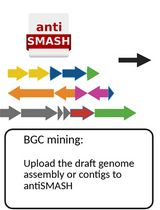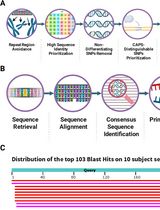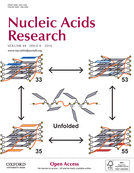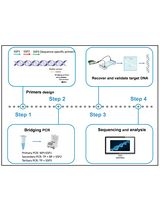- Submit a Protocol
- Receive Our Alerts
- Log in
- /
- Sign up
- My Bio Page
- Edit My Profile
- Change Password
- Log Out
- EN
- EN - English
- CN - 中文
- Protocols
- Articles and Issues
- For Authors
- About
- Become a Reviewer
- EN - English
- CN - 中文
- Home
- Protocols
- Articles and Issues
- For Authors
- About
- Become a Reviewer
Knock-in Blunt Ligation Utilizing CRISPR/Cas9
Published: Vol 7, Iss 5, Mar 5, 2017 DOI: 10.21769/BioProtoc.2163 Views: 10696
Reviewed by: Renate WeizbauerAnnis Elizabeth RichardsonPriyanka Das

Protocol Collections
Comprehensive collections of detailed, peer-reviewed protocols focusing on specific topics
Related protocols

A Rapid and Cost-Effective Pipeline to Identify and Capture BGCs From Bacterial Draft Genomes
Marco A. Campos-Magaña [...] Luis Garcia-Morales
Dec 20, 2025 517 Views

CAPS-Based SNP Genotyping for Nitrogen-Response Phenotypes in Maize Hybrids
Jannis Jacobs [...] Peter K. Lundquist
Dec 20, 2025 410 Views
Abstract
The incorporation of the CRISPR/Cas9 bacterial immune system into the genetic engineering toolbox has led to the development of several new methods for genome manipulation (Auer et al., 2014; Byrne et al., 2015). We took advantage of the ability of Cas9 to generate blunt-ended double-strand breaks (Jinek et al., 2012) to introduce exogenous DNA in a highly precise manner through the exploitation of non-homologous end-joining DNA repair machinery (Geisinger et al., 2016). This protocol has been successfully applied to traditional immortalized cell lines and human induced pluripotent stem cells. Here we present a generalized protocol for knock-in blunt ligation, using HEK293 cells as an example.
Keywords: CRISPR/Cas9Background
At the time we conceptualized knock-in blunt ligation (Geisinger et al., 2016), the vast majority of methods developed for use with CRISPR/Cas9 were focused on enhancing the efficiency of homologous recombination. However, there was one exception: a homology-independent, plasmid-based knock-in method developed in zebrafish (Auer et al., 2014). This method, like knock-in blunt ligation, relies on the machinery of canonical non-homologous end-joining to insert a linearized, blunt-ended, double-stranded DNA fragment into a genomic double-strand break with a high degree of precision and minimal loss of nucleotides. Both methods are similar to a method developed for zinc-finger nucleases and TALENs known as obligate ligation-gated recombination (ObLiGaRe; Maresca et al., 2013), which relied on the generation of compatible overhangs to facilitate insertion of target DNA into the genome. Both the Auer method and ObLiGaRe rely on delivery of a vector bearing the desired transgene construct, which could lead to incorporation of undesirable exogenous sequences. Because of the propensity of Staphylococcus pyogenes Cas9 to make blunt-ended double-strand breaks, we reasoned that exogenous sequence delivery in genome engineering experiments could be limited to solely the CRISPR/Cas9 expression vector and a PCR-generated amplicon of solely the sequence of interest. Thus, knock-in blunt cloning possesses the dual advantages of minimizing the introduction of exogenous sequences and its reliance on canonical non-homologous end-joining rather than homologous recombination. While the following protocol is specifically for human HEK293 cells, we note that this method is likely to be broadly applicable to eukaryotic cells.
Materials and Reagents
- ChromaSpin+TE-1,000 chromatography columns (Takara Bio, Clontech, catalog number: 636079 )
- Falcon® polystyrene 24-well tissue culture microplates (Corning, Falcon®, catalog number: 353226 )
- Thin-walled PCR tubes (Thermo Fisher Scientific, Thermo ScientificTM, catalog number: AB1182 )
- Falcon® test tube with cell strainer snap cap (Corning, Falcon®, catalog number: 352235 )
- Falcon® polystyrene 96-well tissue culture microplates, flat bottom (Corning, Falcon®, catalog number: 353916 )
- 1.75 ml microcentrifuge tubes
Note: Manufacturer does not matter. - Optional: 10-cm tissue culture dishes (Corning, catalog number: 353003 )
- A human cell line, such as HEK293
- Avector that expresses the guide RNA or RNAs of interest and Cas9 (e.g., Addgene, catalog number: 42230 )
- Double-stranded DNA template, preferably plasmid
- DNA oligos containing three phosphorothioate bonds at the 5’ end of each oligo for PCR amplification of a template
- A high-fidelity, blunt-end generating DNA polymerase: Phusion (New England Biolabs, catalog number: E0553S ) or Q5 (New England Biolabs, catalog number: M0491S ), with associated buffer, are the only acceptable polymerases for this protocol
- 10 mM dNTPs (New England Biolabs, catalog number: N0446S )
- MinElute PCR Purification Kit (QIAGEN, catalog number: 28004 )
- FastDigest DpnI (Thermo Fisher Scientific, Thermo ScientificTM, catalog number: FD1703 )
- Nuclease-free water
- A transfection reagent such as FuGENE® HD (Promega, catalog number: E2311 )
- Opti-MEM I media (Thermo Fisher Scientific, GibcoTM, catalog number: 31985062 )
- NucBlue® Fixed Cell Stain ReadyProbes® reagent (Thermo Fisher Scientific, Molecular ProbesTM, catalog number: R37606 )
- Phosphate buffered saline (PBS)
- 0.05% trypsin-EDTA (Thermo Fisher Scientific, GibcoTM, catalog number: 25300054 )
- DMEM, high glucose (Thermo Fisher Scientific, GibcoTM, catalog number: 11965092 )
- Fetal bovine serum (FBS)
- 0.5 M EDTA, pH 8.0 (Thermo Fisher Scientific, InvitrogenTM, catalog number: 15575020 )
- Growth media (see Recipes)
- FACS media (see Recipes)
Equipment
- PCR thermocycler (Bio-Rad Laboratories, catalog number: 1861096 )
- Tissue culture hood, Type B2 biological safety cabinet (e.g., Thermo Fisher Scientific, Thermo ScientificTM, model: 1300 Series Class II )
- Incubator (37 °C and 5% CO2) (e.g., Thermo Fisher Scientific, Thermo ScientificTM, model: Series 8000 )
- Microcentrifuge (e.g., Eppendorf, model: 5424 )
- FACSAria II cell sorter (BD)
- Hemocytometer (Neubauer chamber) or equivalent method
Procedure
- Generation of the knock-in blunt ligation cassette
- Set up a minimum of 8 PCR reactions according to the manufacturer’s instructions using 1 ng of double-stranded DNA template and a minimum reaction volume of 50 µl. Carry out the PCR on a thermocycler using appropriate parameters.
- Following PCR, pool the reactions and purify the product using the MinElute PCR Purification Kit according to the manufacturer’s instructions. Elute in 20 µl of the provided EB buffer.
- To remove carried-over plasmid, perform a restriction digest using FastDigest DpnI. Use a reaction volume of 30 µl and the following thermocycler protocol:
37 °C for 1 h
80 °C for 10 min
12 °C for infinity - Bring the reaction to 100 µl with nuclease-free water and purify the cassette product from the digest using a CHROMASpin+TE-1000 chromatography column according to the manufacturer’s instructions (see Note 1).
- Set up a minimum of 8 PCR reactions according to the manufacturer’s instructions using 1 ng of double-stranded DNA template and a minimum reaction volume of 50 µl. Carry out the PCR on a thermocycler using appropriate parameters.
- Knock-in blunt ligation
- One day prior to transfection, plate 150,000 to 500,000 HEK293 cells per well in a 24-well plate in 500 µl of growth media and place in a tissue culture incubator.
- On the day of transfection, assemble the transfection reactions in microcentrifuge tubes in a tissue culture hood using 100-200 ng of purified cassette, 0.5-1.5 µg of guide RNA + Cas9 vector, FuGENE® HD reagent at a 3:1 reagent-to-DNA ratio, and Opti-MEM I to 50 µl. Perform each reaction in triplicate, making sure to include a negative (transfection reagent alone) control. Vortex the reactions briefly and incubate at room temperature for 30 min.
- After 30 min, aspirate media from cells and replace with 500 µl of fresh growth media. Remove 50 µl of media from each well. Then, add the transfection reaction dropwise to each well, followed by gently swirling the plate to mix. Place the plate in a tissue culture incubator.
- Two days post-transfection, trypsinize cells (see Note 2), harvest in microcentrifuge tubes, spin down at 300 x g for 5 min in a microcentrifuge, and aspirate the supernatant. Then, resuspend the pellets in 200 µl of FACS media supplemented with NucBlue® Fixed Cell Stain ReadyProbes® reagent and filter the cell suspension through the strainer of a Falcon test tube. Place tubes on ice, protected from light.
- Using a FACSAria II flow cytometer, clone individual cells into individual wells of a 96-well plate containing 200 µl growth media. Briefly centrifuge (300 x g) the plate after cloning and place in a tissue culture incubator for 5 days undisturbed (see Note 3). Note that this cloning process is greatly facilitated by a fluorescent reporter, either in the cassette or on the Cas9 expression vector (see Note 4).
- After 5 days, replace old media with 200 µl of fresh media regularly until colonies are large enough to passage.
- When passaging colonies for the first time, reserve half of the cells in each colony for diagnostic PCR to identify which colonies contain the desired knock-in event.
- One day prior to transfection, plate 150,000 to 500,000 HEK293 cells per well in a 24-well plate in 500 µl of growth media and place in a tissue culture incubator.
Data analysis
Examples of flow plots and average percentages of transfected cells along with sequencing data from successfully knocked-in alleles for HEK293 and human induced pluripotent stem cells can be found in the original paper (Geisinger et al., 2016; Link to paper). Additionally, diagrams of the procedure, as well as examples of knock-in cassettes, can be found in the original paper.
Notes
- Alternatively, steps A2-A4 can be replaced with gel electrophoresis followed by gel extraction.
- To trypsinsize cells, first aspirate media. Then, wash with 1 ml of PBS followed by 200 µl of 0.05% trypsin-EDTA. Place cells in tissue culture incubator at 37 °C for 10 min. Remove cells from incubator and add 800 µl growth media before harvesting.
- As an alternative to cloning individual cells, serial dilution plating may be used, with the caveat that more time and more plates may be required to obtain a desired clone.
- If using a fluorescent reporter or drug resistance-based selection, cells from the transfection alternatively can be sorted into one pool and plated sparsely on 10-cm tissue culture dishes in growth media to generate colonies.
Recipes
- Growth media
450 ml high-glucose DMEM
50 ml FBS - FACS media
488 ml PBS
10 ml FBS
2 ml 0.5 M EDTA
Acknowledgments
This protocol was originally published as part of Geisinger et al. (2016). The authors wish to thank past members of the Calos lab for helpful discussions. Special thanks to the Stanford Shared FACS Facility and NIH S10 Shared Instrument Grant S10RR025518-01 and the California Institute for Regenerative Medicine TR4-06711 for funding.
References
- Auer, T. O., Duroure, K., De Cian, A., Concordet, J. P. and Del Bene, F. (2014). Highly efficient CRISPR/Cas9-mediated knock-in in zebrafish by homology-independent DNA repair. Genome Res 24(1): 142-153.
- Byrne, S. M., Ortiz, L., Mali, P., Aach, J. and Church, G. M. (2015). Multi-kilobase homozygous targeted gene replacement in human induced pluripotent stem cells. Nucleic Acids Res 43(3): e21.
- Geisinger, J. M., Turan, S., Hernandez, S., Spector, L. P. and Calos, M. P. (2016). In vivo blunt-end cloning through CRISPR/Cas9-facilitated non-homologous end-joining. Nucleic Acids Res 44(8): e76.
- Jinek, M., Chylinski, K., Fonfara, I., Hauer, M., Doudna, J. A. and Charpentier, E. (2012). A programmable dual-RNA-guided DNA endonuclease in adaptive bacterial immunity. Science 337(6096): 816-821.
- Maresca, M., Lin, V. G., Guo, N. and Yang, Y. (2013). Obligate ligation-gated recombination (ObLiGaRe): custom-designed nuclease-mediated targeted integration through nonhomologous end joining. Genome Res 23(3): 539-546.
Article Information
Copyright
© 2017 The Authors; exclusive licensee Bio-protocol LLC.
How to cite
Geisinger, J. M. and Calos, M. P. (2017). Knock-in Blunt Ligation Utilizing CRISPR/Cas9. Bio-protocol 7(5): e2163. DOI: 10.21769/BioProtoc.2163.
Category
Plant Science > Plant molecular biology > DNA
Molecular Biology > DNA > Mutagenesis
Molecular Biology > DNA > DNA cloning
Do you have any questions about this protocol?
Post your question to gather feedback from the community. We will also invite the authors of this article to respond.
Share
Bluesky
X
Copy link










